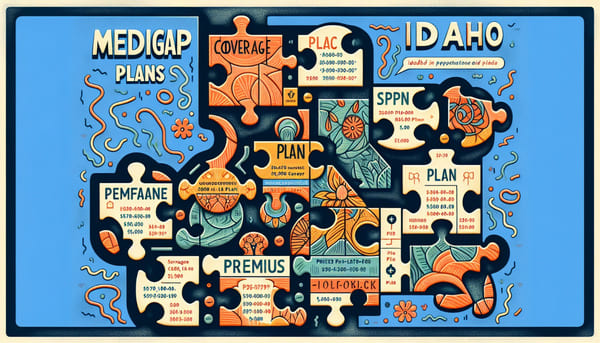
by Russell Noga | Updated April 14th, 2024
Searching for information on Medicare supplement plans in Idaho for 2025? You’ve come to the right place. If you’re an Idaho resident navigating the Medigap policy landscape for Medicare supplement Plans Idaho 2025, knowing your options is critical. This guide unpacks the range of plans available, outlines recent changes, and helps you understand which Medigap policy could best fit your healthcare needs without the fluff. Stay informed on eligibility, costs, and how to choose the right plan as we dive into the details of what Idaho has to offer for supplemental Medicare insurance.
Key Takeaways
- Idaho offers eleven standardized Medigap plans, which differ in premium costs across insurance companies, and eligibility is not solely based on age, as those with certain disabilities or conditions like ALS or ESRD are also eligible.
- Medigap Plan G, Plan F, and Plan N are notable Medigap policies in Idaho for 2025, each with unique coverage and costs; eligibility for Plans C and F is restricted to beneficiaries who became eligible for Medicare before Jan 1, 2020.
- Idaho has implemented several changes and policies to assist beneficiaries, including a community rating system, the ‘Birthday Rule’ for plan changes without medical underwriting, and financial assistance programs for those struggling with costs.
Compare 2025 Plans & Rates
Enter Zip Code
Understanding Medicare Supplement (Medigap) Plans in Idaho for 2025

Medigap, as the name implies, is designed to fill the gaps in Original Medicare coverage. These plans are an integral part of the healthcare landscape in Idaho, offering a lifeline to those grappling with expenses not covered by Original Medicare, such as coinsurance and deductibles. In Idaho, there’s no shortage of options when it comes to choosing a Medigap plan. The state offers eleven standardized Medigap plans, each identified by a letter from A through N.
While the benefits of these plans remain consistent across different insurance companies, the premiums can vary. That’s right – even though the coverage is standardized, you might find yourself paying more (or less) for a Medigap plan, depending on the insurance company you choose. This highlights the importance of shopping around and comparing prices before settling on a Medigap plan in Idaho.
Eligibility and Enrollment: Navigating Medigap in Idaho
Eligibility for Medicare and Medigap typically commences when Americans, including Idaho residents, hit the golden age of 65. However, it’s not just the over-65s who can reap the benefits of these plans. Younger individuals may qualify for Medicare and Medigap if they have been receiving disability benefits for 24 months or if they have Amyotrophic Lateral Sclerosis (ALS) or end-stage renal disease (ESRD).
In Idaho, insurance companies are mandated to offer Medicare Supplement plans to individuals under 65 during their Medicare Initial Enrollment Period. Furthermore, premiums for Medigap policies are determined using a community rating system, meaning they are not based on the applicant’s age. Although, it’s worth mentioning that insurance companies in Idaho can charge up to 150% of the premiums charged to those who are 65 for Medicare Supplement plans to beneficiaries under 65.
Age and Health Requirements for Medigap Eligibility
Eligibility for Medigap doesn’t just come with an age requirement. In Idaho, Medigap insurers are required to offer policies to eligible individuals under the age of 65. This includes those with disabilities who are granted access to these plans during their Medicare Initial Enrollment Period or any guaranteed issue periods.
While this opens up Medigap to a broader demographic, it’s important to note that premiums for Medigap enrollees under 65 with disabilities in Idaho are capped at 150% of the rates for beneficiaries who are 65 years old. Furthermore, Medicare beneficiaries under 65 in Idaho who suffer from ESRD or ALS have specific eligibility criteria for enrolling in Medigap plans.
Top Medicare Supplement Plans in Idaho for 2025

Venturing into 2025, Idaho showcases a variety of distinguished Medicare Supplement plans. Prominent among them is Plan G, offered by Aetna, which stands out for its comprehensive coverage. While this plan does not include the Part B deductible, it does provide significant coverage for foreign travel exchange within the plan’s limits.
Plan F, also available through Aetna, is recognized for its extensive coverage, which includes both Part A and Part B deductibles, making it a desirable option for many. Like Plan G, it also covers foreign travel exchanges by up to the same percentage.
UnitedHealthcare is a leading provider of Medicare Supplement Plan N in Idaho. This plan is designed to be more budget-friendly, excluding coverage for Part B deductibles and excess charges. Yet, it maintains the same level of coverage for foreign travel exchange as the plans as mentioned above.
Medicare Plan G Benefits for Idaho Residents in 2025
Medicare Plan G stands out as a premier choice for Idaho residents looking for comprehensive Medigap coverage. As one of the standardized Medicare Supplement plans, Plan G offers extensive benefits, covering most of the out-of-pocket costs associated with Original Medicare, except for the Medicare Part B deductible.
One key advantage of Plan G is its coverage of Medicare Part A deductible and coinsurance, which includes hospitalization costs, hospice care coinsurance, and skilled nursing facility coinsurance. Additionally, Plan G covers the full 20% coinsurance required for Medicare Part B medical expenses, such as doctor visits and outpatient therapy.
For those who love to travel, Plan G is beautiful, as it provides emergency health care coverage for foreign travel up to the plan limits. This benefit offers peace of mind for globetrotters who want to ensure they have access to necessary medical care while abroad.
Another significant benefit of Plan G is the coverage of Part B excess charges. This means that if a healthcare provider charges more than the Medicare-approved amount for a service, Plan G will cover the difference, ensuring that Idaho residents are not left with unexpected medical bills.
Furthermore, Plan G offers a high-deductible version for those who prefer a lower monthly premium in exchange for a higher annual deductible. This high-deductible Plan G option requires beneficiaries to pay all Medicare-covered costs up to the deductible amount before the plan begins to pay. Once the deductible is met, the high-deductible Plan G provides the same comprehensive coverage as the standard Plan G for the rest of the calendar year.
In Idaho, Plan G’s popularity continues to grow due to its robust coverage and the fact that it is available to beneficiaries who became eligible for Medicare after January 1, 2020. As Medicare evolves, Plan G remains a top choice for those seeking to minimize out-of-pocket healthcare expenses and gain extensive coverage benefits.
High Deductible Plan G in Idaho
High Deductible Plan G is a sought-after choice for Idaho residents who appreciate the comprehensive coverage of the standard Plan G but are looking for a more budget-friendly monthly premium. This plan variant requires beneficiaries to pay all Medicare-covered costs up to a certain deductible amount before the plan starts to cover expenses. After this deductible is met, High Deductible Plan G provides the same extensive benefits as the standard Plan G, including coverage for Part A deductible, Part B coinsurance, and excess charges, as well as foreign travel emergency healthcare. It’s an attractive option for those who are generally healthy and want to manage their monthly healthcare expenses while maintaining a safeguard against potential high-cost medical events.
Medicare Plan F 2025
Plan F has long been a favorite among Medicare beneficiaries for its comprehensive coverage. It’s the Medigap plan that leaves beneficiary with the fewest out-of-pocket expenses. However, there’s a significant change to note for those looking into their options in 2025. As of January 1, 2020, Medigap plans sold to new Medicare beneficiaries are not allowed to cover the Part B deductible. This rule means that Plan F, along with Plan C, is not accessible to anyone who became eligible for Medicare on or after that cutoff date.
For those who had already enrolled in Medicare before January 1, 2020, or who already had Plan F, there is good news: they are grandfathered in and can keep their Plan F coverage or even switch to Plan F from another plan if they choose to do so. This ensures that these beneficiaries can continue to enjoy the full benefits of Plan F, which includes coverage of the Part B deductible, 100% of Part B coinsurance, and more.
In addition to the standard Plan F, a high-deductible version is available. The high-deductible Plan F requires beneficiaries to pay all Medicare-covered costs up to a certain deductible amount before the plan begins to pay. In 2024, this deductible amount was $2,800, and while the deductible amount for 2025 has yet to be announced, it could be adjusted for inflation.
Due to its extensive coverage, Plan F remains an attractive option for eligible beneficiaries. However, it’s important for all beneficiaries to stay informed about the changes and consider how they might affect their eligibility and coverage choices in the future.
Compare Medicare Plans & Rates in Your Area
Medicare Plan N 2025: A Comparative Look with Plan G
Medicare Plan N is an attractive Medigap option that shines alongside the popular Plan G. While Plan G is often hailed for its comprehensive coverage, Plan N emerges as a cost-effective alternative with its own set of benefits and cost-sharing measures. Plan N fully covers Part B coinsurance charges, with the exception of a small copayment of up to $20 for some office visits and up to $50 for emergency room visits that don’t result in an inpatient admission.
Comparatively, Plan G covers the Part B deductible and does not require copayments for office and emergency room visits, which may make it a preferable choice for those seeking more predictable healthcare spending. However, Plan N’s lower premium might appeal to beneficiaries who are comfortable with minor out-of-pocket expenses in exchange for reduced monthly costs.
Both Plan G and Plan N offer 80% coverage for foreign travel emergency healthcare, but Plan G has the added benefit of covering Part B excess charges, which are not covered under Plan N. This means that with Plan G, beneficiaries are protected if a healthcare provider charges more than the Medicare-approved amount for a service.
The consistency in benefits across different insurance companies for both plans is due to their standardized nature. However, the demand for Plan N may see an uptick as Plans C and F are no longer available to newly eligible Medicare members from January 1, 2020, onwards. This shift could position Plan N as a more prominent player for those entering the Medigap market post-2020.
The Open Enrollment Period for Medigap in Idaho
Each year, Idaho residents have a one-time, six-month Open Enrollment Period for Medigap that begins when they are at least 65 years old and enrolled in Medicare Part B. This period is also granted to disabled individuals under the age of 65 who are newly enrolled in Medicare Part B.
During this Open Enrollment Period, all available Medigap plans are guaranteed-issue. However, it’s worth noting that insurance companies offering Medicare Plan N in Idaho might have pre-existing condition look-back periods, which could affect enrollees during the Open Enrollment Period.
Special Enrollment Scenarios
In addition to the Open Enrollment Period, Idaho also offers special enrollment scenarios. For instance, the state’s ‘Birthday Rule’ permits current Medigap policyholders to switch to a new policy with similar or lesser coverage without underwriting during a 63-day period starting on their birthday.
This rule allows for annual plan changes to a different insurance company and different plans without considering health conditions. After December 15, 2023, it will be important to use a special enrollment period if you need to enroll in or make changes to your Medigap plans. This will ensure that you have the necessary coverage for your healthcare needs.
2025’s Medigap Plan Options in Idaho: What’s New?
As we move into 2025, Idaho’s Medigap plans are undergoing a few changes. For instance, the state has transitioned to a community-rated system, where premium rates for new Medigap policies are not based on the applicant’s age.
There has also been a notable shift in preference towards Medigap Plan G, now the most popular plan among Idaho residents who turned 65 after January 1, 2020. In addition, Idaho’s rule changes have addressed the practice of dead-pooling, prohibiting insurers from locking consumers into their current plan and allowing annual plan changes regardless of health conditions.
Comparing Medigap Plans: Finding the Right Fit

Choosing the right Medigap plan is a crucial decision that requires careful consideration. Beneficiaries can find the most suitable plan by carefully comparing each plan’s summary of benefits with their personal healthcare usage patterns and preferences.
It’s also important to consider how different Medigap policies handle out-of-pocket expenses for specific illnesses. While low-cost Medigap plans may not significantly reduce out-of-pocket costs for all services, higher-cost plans often provide greater financial protection with additional covered services.
Coverage Benefits Across Different Medigap Plans
In Idaho, Medigap policies are standardized under federal rules, offering eleven different plans labeled from ‘A’ through ‘N’, each with its specific set of standardized benefits. These plans offer a range of benefits, from Part B coinsurance to coverage for specific services, all aimed at meeting the varied needs of beneficiaries.
Some plans, like Plan N, require beneficiaries to pay 100% of Part B coinsurance and include additional co-payments for certain services. On the other hand, private plans with higher premiums, like Plan G, often provide more comprehensive benefits. These variances underscore the importance of a thorough comparison of coverage benefits across different Medigap plans.
Analyzing Premiums and Out-of-Pocket Costs
In addition to health coverage benefits, it’s also crucial to analyze premiums and out-of-pocket costs for Medigap plans. Beneficiaries should consider the annual premium cost of Medigap policies in relation to the out-of-pocket costs they would incur for specific health conditions.
Understanding the total charges for healthcare services, including health insurance, helps estimate potential costs. Moreover, an analysis of out-of-pocket limits is essential for assessing Medigap plans with cost-sharing features, as these limits cap the policyholder’s annual expenses.
Medicare Advantage vs. Medigap: Understanding Your Choices in Idaho

When choosing a health plan, it’s crucial to understand the difference between Medicare Advantage and Medigap plans. While Medicare Advantage plans may offer lower or no premiums, they can come with higher potential out-of-pocket costs. On the other hand, Medigap plans typically have higher premiums but provide broader coverage.
Another key difference lies in the additional services offered by a Medicare Advantage plan. While Medigap plans do not cover prescription drugs, necessitating a separate Medicare Part D plan, most Medicare Advantage plans include prescription drug coverage. Moreover, Medicare Advantage plans often include additional services like routine dental and vision care.
Financial Assistance and Cost Sharing in Idaho

Financial assistance can be a lifesaver for Medicare beneficiaries struggling with healthcare costs. In Idaho, several programs, including the Qualified Medicare Beneficiary (QMB), Specified Low-Income Medicare Beneficiary (SLMB), and Qualifying Individual (QI) programs, help with Part A and B premiums, deductibles, and copays.
Eligibility for these programs is based on specific income and asset limits, with more comprehensive qualifications for individuals under the age of 65 who are working and have higher monthly incomes. Furthermore, the Idaho Medigap Household Discount offers a premium discount for each member when two policies are issued by the same company to two people living in the same household.
How to Switch or Drop a Medigap Plan in Idaho
There might come a time when you need to switch or drop your Medigap plan. In Idaho, the ‘Birthday Rule’ allows policyholders a 63-day window around their birthday to switch to equivalent or lesser Medigap coverage without medical underwriting.
To drop a Medigap policy, policyholders must contact the insurance company directly for cancellation. However, those with a Medigap policy less than six months old may face a waiting period for new coverage of pre-existing conditions when switching policies.
The Impact of State Legislation on Idaho Medigap Plans
State legislation plays a significant role in shaping the landscape of Medigap plans. In Idaho, the legislation mandates a minimum of 65% of premiums received by Medigap insurers to be spent on enrollee benefits and bars the use of attained-age rating for determining premium increases.
Additionally, the introduction of the ‘Medigap birthday rule’ and the move to a community rating system for Medigap policies have resulted in a more accessible and fairer system for beneficiaries. Also, guaranteed issue rights have been strengthened, providing fairer access to Medigap policies for all, including those with existing conditions and those under 65.
Staying Informed: Idaho Department of Insurance Resources
The Idaho Department of Insurance is a valuable resource for staying informed about Medigap plans. It offers:
- Detailed guides and resources
- Rate charts
- Lists of innovative benefits each Medigap plan offers
- Contact information for each insurance company.
For personal assistance and more detailed information, beneficiaries are directed to contact the department directly.
Summary
We’ve journeyed through the landscape of Medigap plans in Idaho, understanding their intricacies, eligibility requirements, top plans for 2025, and the impact of state legislation. We have also compared Medigap plans, analyzed premiums and out-of-pocket costs, and learned how to switch or drop a plan. As we move forward, remember that choosing the right Medigap plan is a personal decision that should be based on your unique health needs and financial situation. Here’s to making informed decisions and taking charge of your health!
Compare 2025 Plans & Rates
Enter Zip Code
Frequently Asked Questions
What is the most popular supplement insurance with Medicare?
The most popular supplement insurance with Medicare is Plan F, which is known for providing comprehensive coverage of Medicare-covered medical expenses. Other popular options include Plan G and Plan N.
Does Idaho have a birthday rule for Medicare Supplement plans?
Yes, Idaho has a Birthday Rule for Medicare Supplement plans that allows for a 63-day period around the policyholder’s birthday to change the plan. The window occurs once per year.
Can I enroll in a Medicare Supplement plan at any time in Idaho?
In Idaho, you can enroll in a Medicare Supplement plan during your Medigap Open Enrollment Period, which begins when you turn 65 and are enrolled in Medicare Part B. This period lasts for six months. After this period, you may still apply for a Medigap plan, but you might be subject to medical underwriting, and acceptance is not guaranteed. Special enrollment periods may also be available based on certain qualifying events or state-specific rules like the ‘Birthday Rule’.
What are Medicare Supplement (Medigap) plans?
Medicare Supplement (Medigap) plans help cover healthcare expenses not covered by Original Medicare, such as coinsurance and deductibles.
How can I switch or drop a Medigap plan in Idaho?
You should contact the insurance company directly to switch or drop a Medigap plan in Idaho. Communicating with the insurance provider for cancellation is essential.
Speak to the Professionals about Medigap Plans and Original Medicare
If you find understanding the benefits involved with Original Medicare and Medigap Plans challenging, you’re not alone. Whether it’s a Medigap plan, or you want to know more about the Medicare Supplement Plans Idaho in 2025, we can help. Call our team at 1-888-891-0229 for a free consultation or complete the contact form on this site, and an expert will call you back at a convenient time.
We have decades of experience advising our clients on the complexities of Medicare and Medigap plans, the benefits, cost and deductibles. We’ll ensure you get the best rate in your state and advice you can trust.



